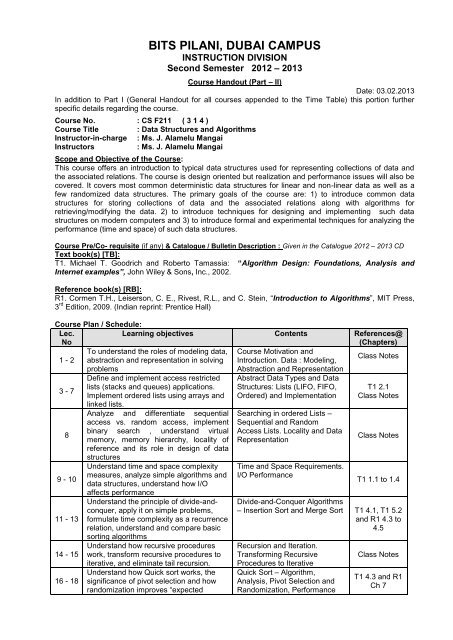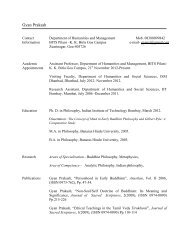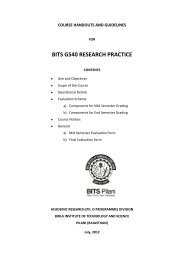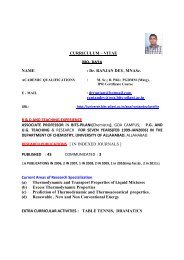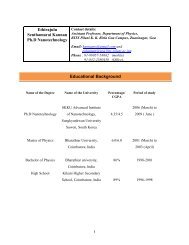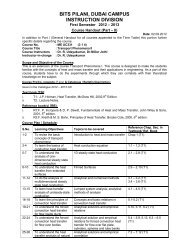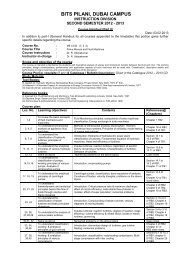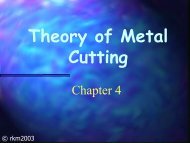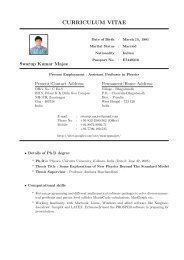Course Handout - Student Welfare Division - BITS Pilani
Course Handout - Student Welfare Division - BITS Pilani
Course Handout - Student Welfare Division - BITS Pilani
You also want an ePaper? Increase the reach of your titles
YUMPU automatically turns print PDFs into web optimized ePapers that Google loves.
<strong>BITS</strong> PILANI, DUBAI CAMPUSINSTRUCTION DIVISIONSecond Semester 2012 – 2013<strong>Course</strong> <strong>Handout</strong> (Part – II)Date: 03.02.2013In addition to Part I (General <strong>Handout</strong> for all courses appended to the Time Table) this portion furtherspecific details regarding the course.<strong>Course</strong> No. : CS F211 ( 3 1 4 )<strong>Course</strong> Title: Data Structures and AlgorithmsInstructor-in-charge : Ms. J. Alamelu MangaiInstructors: Ms. J. Alamelu MangaiScope and Objective of the <strong>Course</strong>:This course offers an introduction to typical data structures used for representing collections of data andthe associated relations. The course is design oriented but realization and performance issues will also becovered. It covers most common deterministic data structures for linear and non-linear data as well as afew randomized data structures. The primary goals of the course are: 1) to introduce common datastructures for storing collections of data and the associated relations along with algorithms forretrieving/modifying the data. 2) to introduce techniques for designing and implementing such datastructures on modern computers and 3) to introduce formal and experimental techniques for analyzing theperformance (time and space) of such data structures.<strong>Course</strong> Pre/Co- requisite (if any) & Catalogue / Bulletin Description : Given in the Catalogue 2012 – 2013 CDText book(s) [TB]:T1. Michael T. Goodrich and Roberto Tamassia: “Algorithm Design: Foundations, Analysis andInternet examples”, John Wiley & Sons, Inc., 2002.Reference book(s) [RB]:R1. Cormen T.H., Leiserson, C. E., Rivest, R.L., and C. Stein, “Introduction to Algorithms”, MIT Press,3 rd Edition, 2009. (Indian reprint: Prentice Hall)<strong>Course</strong> Plan / Schedule:Lec.NoLearning objectives Contents References@(Chapters)To understand the roles of modeling data, <strong>Course</strong> Motivation and1 - 2 abstraction and representation in solving Introduction. Data : Modeling,Class NotesproblemsAbstraction and Representation3 - 789 - 1011 - 1314 - 1516 - 18Define and implement access restrictedlists (stacks and queues) applications.Implement ordered lists using arrays andlinked lists.Analyze and differentiate sequentialaccess vs. random access, implementbinary search , understand virtualmemory, memory hierarchy, locality ofreference and its role in design of datastructuresUnderstand time and space complexitymeasures, analyze simple algorithms anddata structures, understand how I/Oaffects performanceUnderstand the principle of divide-andconquer,apply it on simple problems,formulate time complexity as a recurrencerelation, understand and compare basicsorting algorithmsUnderstand how recursive procedureswork, transform recursive procedures toiterative, and eliminate tail recursion.Understand how Quick sort works, thesignificance of pivot selection and howrandomization improves “expectedAbstract Data Types and DataStructures: Lists (LIFO, FIFO,Ordered) and ImplementationSearching in ordered Lists –Sequential and RandomAccess Lists. Locality and DataRepresentationTime and Space Requirements.I/O PerformanceT1 2.1Class NotesClass NotesT1 1.1 to 1.4Divide-and-Conquer Algorithms– Insertion Sort and Merge Sort T1 4.1, T1 5.2and R1 4.3 to4.5Recursion and Iteration.Transforming RecursiveProcedures to IterativeQuick Sort – Algorithm,Analysis, Pivot Selection andRandomization, PerformanceClass NotesT1 4.3 and R1Ch 7
19 - 2021 - 232425 - 2627 - 29303132-3334-3536-373839-4041-43performance”Understand how bucket sort and Radixsort workUnderstand the significance of hashfunctions and hash tables in providingefficient lookupUnderstand the need for probabilistic datastructure and Bloom filtersUnderstand how to model partiallyordered dataImplement binary search trees and heightbalancing techniqueUnderstand how to model data usingTrees, implement trees with fixed andarbitrary branching and tree traversaltechniquesUnderstand Tries and its VariantsImplement and use heapsUnderstand issues in concurrent accessto data structuresUnderstand B-TreesModel binary relations using graphs,understand graph operationsUnderstand and implement algorithms forgraph traversal, testing connectivity andfinding connected componentsUnderstand how to model data usingweighted graphs, shortest path algorithmsand MST algorithmsImprovementsBucket Sort and Radix Sort T1 4.5Hashing and Hash Tables –Unordered Dictionary, HashFunctions and Collision,Separation Chaining, OpenAddressed Hash Tables andProbing Techniques, AnalysesBloom filters – Motivation,Design and AnalysisPartially Ordered Data –Modeling using Trees, BinaryTrees, Tree TraversalsOrdered Dictionaries: BinarySearch Trees – Operations andanalysis, Height BalancedBSTs.Generalized Trees and treeTraversalsT1 2.5 and R111.2 to 11.4Class NotesT1 2.3T1 3.1 to 3.2Class NotesOrdered Dictionaries: Tries,analysis, Variants T1 9.2Partially ordered Data – Heaps,Analysis, Applications T1 2.4Concurrent Operations on DataStructures – Issues andSolutionsExternal Memory DataStructures – B-Trees, Analysisand VariantsModeling Binary Relationsusing Graphs. GraphRepresentationsGraphs – Traversals,Connectivity and ConnectedComponentsWeighted Graphs – Modeling,Shortest Paths and MinimalSpanning TreesClass NotesR1 Ch 18T1 6.1 to 6.2T1 6.3 to 6.4T1 7.1 to 7.3* The lectures may be slightly diverge from aforesaid plan based on students ‘background & interest in the topic, whichmay perhaps include special lectures and discussions that would be planned and schedule notified accordinglyList of Lab ExercisesSl. NoLab. Exercise1. Stack manipulation2. Stack Application3. Queue Manipulation4. Circular queue5. List Operations6. Linear and Binary search7. Merge sort and insertion sort8. Recursion9. Bucket Sort and Radix Sort10. Hashing11. Tree Operations – BST (creation, traversals)
To be announcedlater12. Tree operations – AVL(creation, display)13. Heaps14. Graphs (representation, insertion, traversals)15. Graphs (shortest path)Evaluation scheme:ECNo.Component Duration Weightage%Date & Time1 Test-I Closed Book 50 minutes 20 18.03.2013, 12.05 – 12.55 p.m.2 Quiz-1 Closed book 20 minutes 05 25.02.13, 12.15 p.m. – 12.35 p.m.3 Test – 2 Open book 1 50 minutes 20 06.05.2013, 12.05 – 12.55 p.m4 Labcontinuous 10 To be announced later( journal + demo)evaluationVenue5 Lab Compre 1 hr 30 mins 10 To be announced later5 Compre Exam Closed Book 3 hours. 35 05.06.2013, Wednesday 12.30p.m. – 3.30 p.m.1 Only prescribed text book(s) and hand written notes are permitted.Practical: The Practical will be conducted on either some or all of the above mentioned topics. Detailswill be intimated through a separate notification or announced in the class and the deadlines would beindicated therein. However all reports would be completed by 2 nd week of May, 2013. It is necessary thatall students stick to time schedule and do not postpone submission of reports. This will prevent extra loadduring last two weeks of class work. No make-ups would be allowed for submission of practical reports.Mid-sem Grading:Mid-sem grading will be displayed after two evaluation components or earlier when- ever about 40 % ofevaluation components are completed.Note: A student will be likely to get “NC”, if he / sheDoesn’t appear / appear for the sake of appearing for the evaluation components / scoring zero inpre-compre total.Scoring zero in the lab component / Abstaining from lab classes throughout.Makeup and Attendance policies:Make-ups are not given as a routine. It is solely dependent upon the genuineness of the circumstancesunder which a student fails to appear in a scheduled evaluation component. In such circumstances, priorpermission should be obtained from the Instructor-in-Charge (I/C).The decision of the I/C in the abovematter will be final.Attendance: Every student is expected to be responsible for regularity of his/her attendance in classrooms and laboratories, to appear in scheduled tests and examinations and fulfill all other tasks assignedto him/her in every course. A student should have a minimum of 50% of attendance in a course to beeligible to appear for the Comprehensive Examination in that course. For the students under the purview ofAcademic Counseling Board (ACB), the Board shall prescribe the minimum attendance requirement on acase-to-case basis. Attendance in the course will be a deciding factor in judging the seriousness of astudent which may be directly / indirectly related to grading.General timings for consultation:Each instructor will specify his / her chamber consultation hours during which the student can contact him /her in his / her chamber for consultation. (For details see part II)General instructions:<strong>Student</strong>s should come prepared for classes and carry the text book(s) or material(s) as prescribed by the<strong>Course</strong> Faculty to the class.Notices:All notices concerning the course will be displayed on the respective Notice Boards.Ms. J. Alamelu MangaiInstructor-in-ChargeContact Details:Ms. J. Alamelu Mangai, Senior Lecturer CSContact Details: Chamber No:333Contact No +971-4-4200700Extn. 442, Email: mangai@bits-dubai.ac.aeMobile No: 050 3987928


